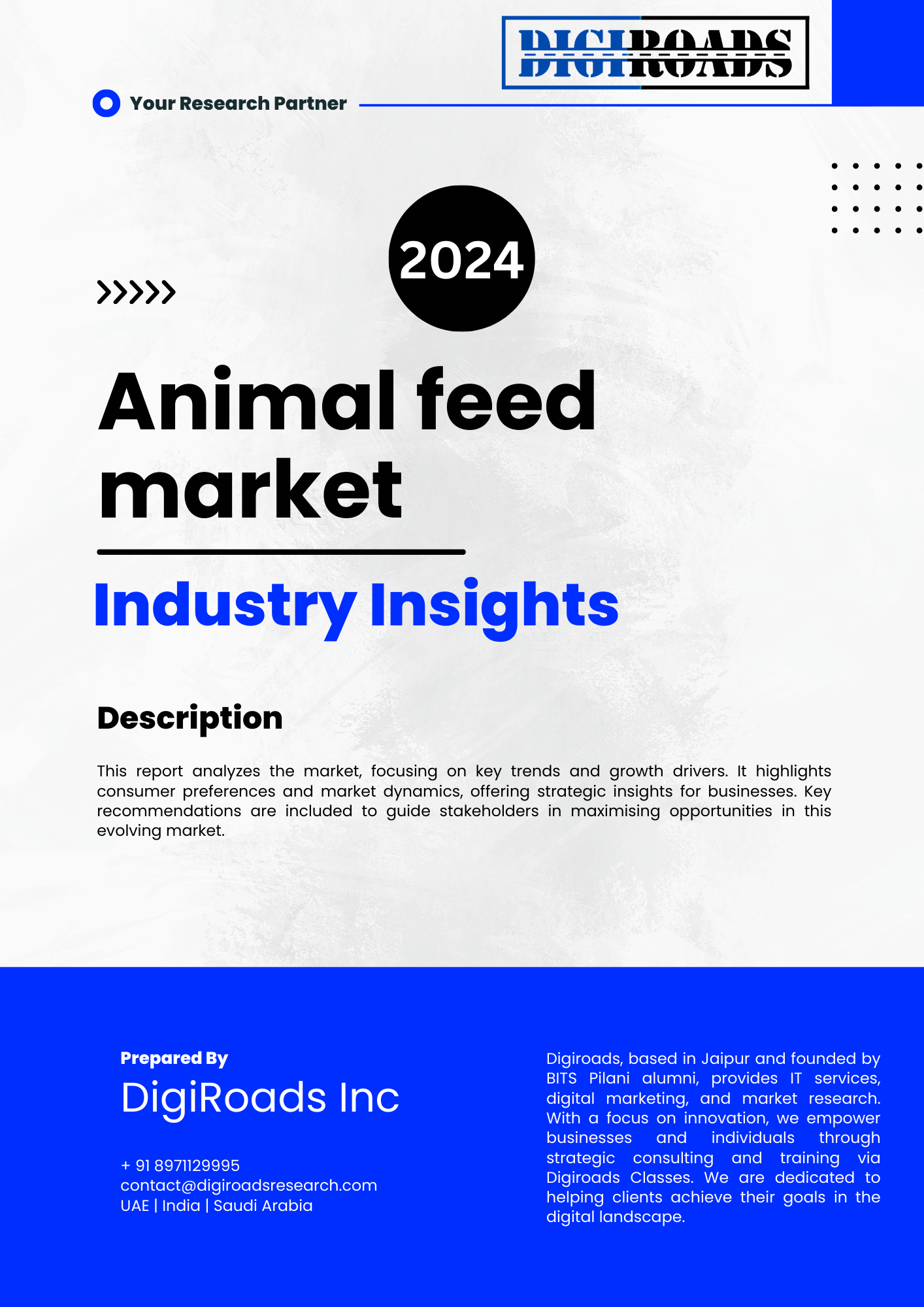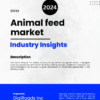No products in the cart.
Animal feed market
- Brand: DigiRoads
[120 Pages] The “Animal Feed Market” report for 2024-2034 offers a detailed analysis of the global industry. It covers market trends, growth drivers, challenges, and opportunities in segments such as poultry feed, swine feed, cattle feed, and regions. Key highlights include market size, player strategies, emerging technologies’ impact, regulatory insights, growth opportunities, and industry challenges.
Category: Agriculture
Brand: DigiRoads
Animal feed market: Opportunity Analysis and Industry Forecast, 2024-2034
Animal feed market Overview:
The animal feed market size reached US$ 580 Billion in 2024 to reach US$ 954.68 Billion by 2034 at a CAGR of 5.3%% during 2024-2034.
The animal feed market is a crucial sector of the global agriculture industry, providing essential nutrition to livestock such as poultry, swine, cattle, and aquaculture. This market encompasses a wide range of feed ingredients, including grains, protein sources (like soybean meal and fishmeal), vitamins, minerals, and additives, all formulated to meet the nutritional needs of various animal species at different stages of growth.
Several factors are driving the growth of the animal feed market. These include the increasing global demand for animal products, driven by population growth, rising incomes, and changing dietary preferences. Technological advancements in feed formulation and processing are also contributing to market growth, enhancing feed efficiency and animal health. Additionally, the expansion of the livestock industry, particularly in emerging economies, is boosting demand for feed to support increased production.
Geographically, Asia Pacific dominates the animal feed market, led by countries like China and India with large and growing livestock sectors. However, regions such as North America and Europe also play significant roles due to technological advancements and stringent regulations. Overall, the animal feed market is expected to continue expanding to meet the growing demand for animal products while addressing challenges related to sustainability, food safety, and animal welfare.
Animal feed market – Report Coverage:
The “Animal feed market Report – Forecast (2024-2034)” by Digiroads Consulting, covers an in-depth analysis of the following segments in the Animal feed market.
| Attribute | Segment |
| By Form |
|
| By Animal Type |
|
| By Ingredient |
|
| By Location |
|
Recent Developments :
- Focus on Alternative Proteins: Driven by sustainability concerns and rising demand for plant-based proteins, companies are developing innovative feed formulations incorporating insect meal, algae, and single-cell proteins as alternatives to traditional protein sources like soy and fishmeal.
- Precision Nutrition Solutions: Advancements in nutritional science are leading to the development of customized feed solutions tailored to specific animal breeds, ages, and production goals. This personalized approach optimizes feed efficiency and animal performance.
Shifting Trends and Consumer Preferences:
- Demand for Sustainable Practices: Sustainability is a growing concern. Consumers are demanding animal products raised with minimal environmental impact. This translates to a rise in demand for feed produced using sustainable practices and reduced reliance on deforestation for animal feed crops.
- Focus on Animal Welfare: Animal welfare concerns are driving a preference for feed that promotes animal health and well-being. This includes feed formulations with prebiotics and probiotics for gut health management, and reduced use of antibiotics in feed production.
Regulatory Considerations:
- Antibiotic Restrictions: Stricter regulations on the use of antibiotics in animal feed are pushing the industry towards alternative solutions for disease prevention and growth promotion.
Examples of Recent Developments:
- June 2023: Cargill, a major animal feed producer, announced its commitment to achieving net-zero emissions in its global supply chain by 2050. This highlights the industry’s growing focus on sustainability
Animal feed market – Dynamics:
Growth Drivers: Rising Protein Demand: The global population’s increasing demand for animal protein, particularly in developing countries, is a major driver. The animal feed industry provides the essential nutritional foundation for meat, milk, and egg production.
- Livestock Population Growth: The global livestock population is projected to rise, further fueling the demand for animal feed to meet growing food needs.
- Focus on Efficiency and Sustainability: With concerns about resource limitations and environmental impact, there’s a growing emphasis on improving feed efficiency. This includes utilizing novel feed ingredients, reducing waste, and adopting sustainable sourcing practices.
Shifting Trends and Consumer Preferences:
- Demand for Sustainable Practices: Consumers are increasingly concerned about the environmental impact of animal agriculture. This translates to a demand for animal feed produced using sustainable practices, such as reducing reliance on deforestation for feed crops and utilizing recycled water in production processes .
- Focus on Animal Welfare: Animal welfare is a growing concern, driving a preference for feed that promotes animal health and well-being. This includes using feed formulations that support gut health and minimize the use of antibiotics.
- Alternative Protein Sources: Sustainability concerns and ethical considerations are driving the exploration of alternative protein sources for animal feed. Examples include insect meal, algae, and single-cell proteins, which can replace traditional ingredients like soy and fishmeal.
Regulatory Landscape:
- Stricter Regulations on Antibiotics: Stringent regulations on antibiotic use in animal feed are a major driver for alternative solutions for disease prevention and growth promotion. Regulatory bodies are also focusing on ensuring feed safety and traceability throughout the supply chain.
Challenges and Considerations:
- Price Volatility: The market is susceptible to fluctuations in the prices of key raw materials like grains and protein sources, impacting affordability for farmers.
- Geopolitical Issues: Geopolitical tensions and trade wars can disrupt supply chains and lead to price fluctuations for feed ingredients.
The Future of the Market:
The future of the animal feed market hinges on innovation and adaptation to meet the evolving needs of consumers, regulatory bodies, and environmental concerns. Key areas of focus will be:
- Sustainable Feed Production: Developing sustainable sourcing practices, reducing environmental footprint, and utilizing recycled resources.
- Alternative Protein Sources: Research and development of viable and cost-effective alternative protein sources for animal feed.
- Precision Nutrition: Customizing feed formulations to optimize animal health, performance, and resource utilization.
- Regulatory Alignment: Navigating the evolving regulatory landscape and ensuring compliance for feed production and ingredients.
By addressing these dynamics, the animal feed market can ensure continued growth while contributing to a more sustainable and responsible food system.
Key Market Players:
Product/Service launches, approvals, patents and events, acquisitions, partnerships and collaborations are key strategies adopted by players in the Animal feed market . The top 10 companies in this industry are listed below:
- Cargill Incorporated
- Archer-Daniels-Midland Company
- Farmers N.V.
- Kemin Industries Inc.
- Nutreco N.V
- Perdue Farms Inc.
- Tyson Foods Inc.
- Charoen Pokphand Group
- Dupont De Nemours Inc.
- Evonik Industries AG (RAG-Stiftung)
Key Benefits For Stakeholders:
- Farmers:
- Improved Animal Health: High-quality feed ensures the health and well-being of livestock, reducing the incidence of diseases and improving overall productivity.
- Enhanced Productivity: Balanced nutrition leads to better growth rates, higher milk and egg production, and improved feed conversion ratios, resulting in increased profitability for farmers.
- Cost Efficiency: Efficient feed utilization reduces feed costs and enhances profitability for farmers.
- Feed Manufacturers:
- Market Opportunities: Growing demand for animal feed presents manufacturers with significant market opportunities, driving revenue growth.
- Product Differentiation: Offering specialized feed formulations tailored to different animal species and production stages allows manufacturers to differentiate their products and attract customers.
- Innovation and Research: Investment in research and development leads to the development of new feed formulations and technologies, improving product quality and performance.
- Suppliers:
- Expanded Product Offerings: Suppliers benefit from offering a diverse range of feed ingredients and additives, meeting the evolving needs of feed manufacturers and farmers.
- Partnerships and Collaborations: Collaborating with manufacturers and farmers to provide technical support, education, and logistics services enhances the value proposition for suppliers.
- Revenue Growth: Increased demand for feed ingredients and additives translates into revenue growth opportunities for suppliers.
- Consumers:
- Access to Quality Animal Products: High-quality feed ensures the production of safe and nutritious animal products such as meat, eggs, and dairy.
- Assurance of Food Safety: Feed quality contributes to food safety by minimizing the risk of contamination and residues in animal products consumed by humans.
- Animal Welfare: Consumers are assured that animals are raised under optimal conditions with proper nutrition, contributing to animal welfare and ethical concerns.
We have studied the Animal Feed Market in 360 degrees via. both primary & secondary research methodologies. This helped us in building an understanding of the current market dynamics, supply-demand gap, pricing trends, product preferences, consumer patterns & so on. The findings were further validated through primary research with industry experts & opinion leaders across countries. The data is further compiled & validated through various market estimation & data validation methodologies. Further, we also have our in-house data forecasting model to predict market growth up to 2034.
Contact us for any inquiry.
Table of Contents- INTRODUCTION
1.1 Study Assumptions & Market Definition
1.2 Scope of the Study
- RESEARCH METHODOLOGY
- EXECUTIVE SUMMARY
- MARKET DYNAMICS
4.1 Market Overview
4.2 Market Drivers
4.3 Market Restraints
4.4 Porter’s Five Forces Analysis
4.4.1 Bargaining Power of Suppliers
4.4.2 Bargaining Power of Buyers
4.4.3 Threat of New Entrants
4.4.4 Threat of Substitute Products
4.4.5 Intensity of Competitive Rivalry
- MARKET SEGMENTATION
- Form:
- Pellets
- Crumbles
- Mash
- Others
- Animal Type:
- Swine
- Ruminants
- Poultry
- Aquaculture
- Ingredient:
- Cereals
- Oilseed Meal
- Molasses
- Fish Oil and Fish Meal
- Additives
- By Location:
- North & South America
- Middle East
- Africa
- Asia Pacific
- Rest of the World
- COMPETITIVE LANDSCAPE
6.1 Most Adopted Strategies
6.2 Market Share Analysis
6.3 Company Profiles
- Cargill Incorporated
- Archer-Daniels-Midland Company
- ForFarmers N.V.
- Kemin Industries Inc.
- Nutreco N.V (SHV Holdings)
- Perdue Farms Inc.
- Tyson Foods Inc.
- Charoen Pokphand Group
- Dupont De Nemours Inc.
- Evonik Industries AG (RAG-Stiftung)
- MARKET OPPORTUNITIES AND FUTURE TRENDS


